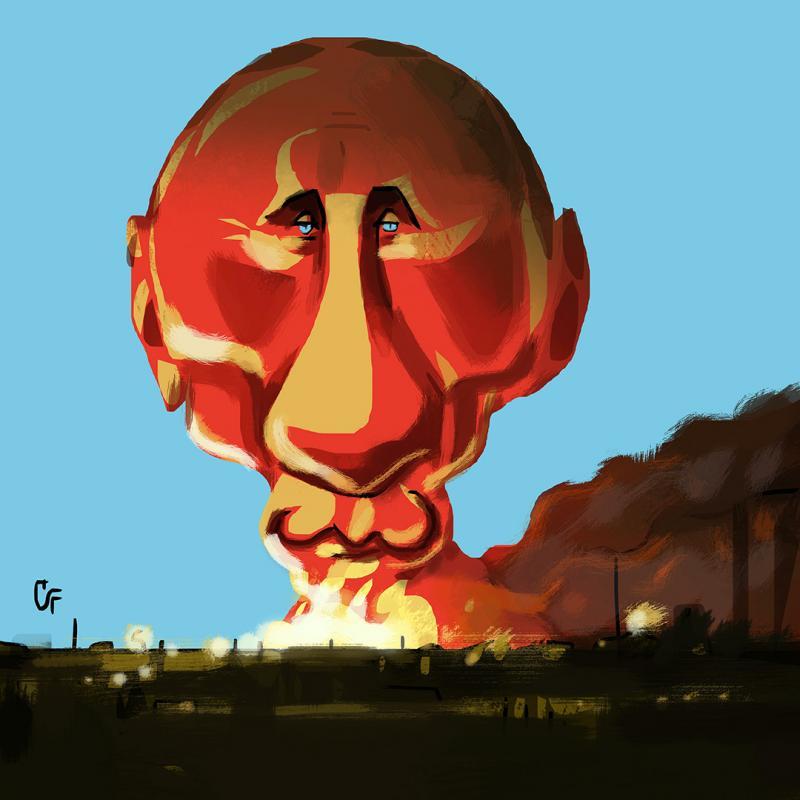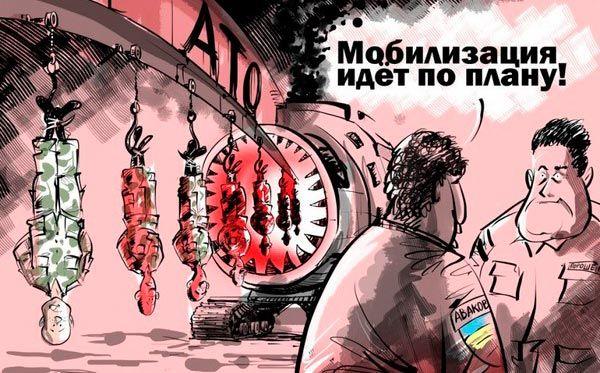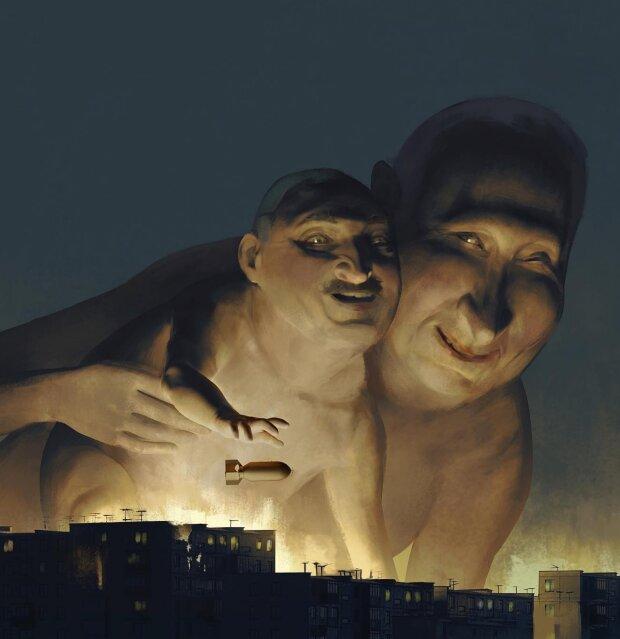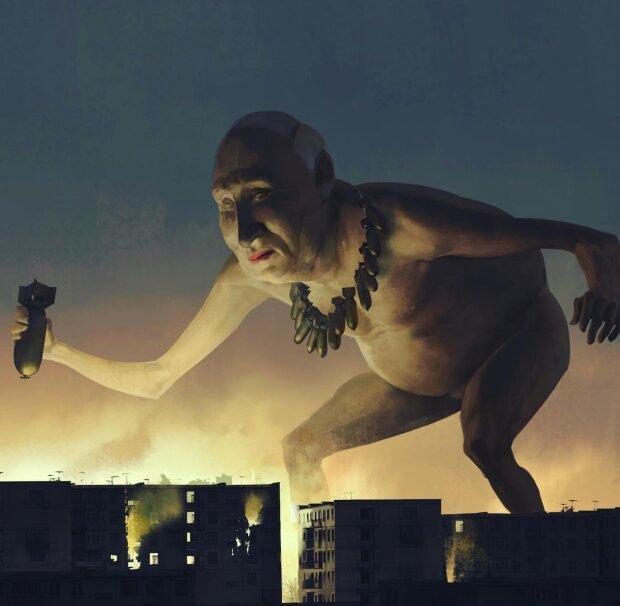
"Mobilisation is going according to plan": caricature art during the Ukraine war
Caricature has emerged as a predominant genre in military propaganda, appearing on the pages of leaflets and in the press. Due to their simplicity and clear interpretations, cartoons are easily comprehensible, making them a powerful method for shaping public opinion. The subtlety of caricature art gives its creators unparalleled power, surpassing that of even writers. The origin of journalistic caricature art can be traced back to the 18th century when the first caricatures of Napoleon appeared. As the 20th century unfolded, caricature art evolved, culminating in powerful and original works during the First and Second World Wars. Unfortunately, in 2022, the world witnessed a similar tragedy as the Russian government launched a war against Ukraine, resulting in a deluge of illustrations from both Western and Eastern artists.
This paper explores the unique art of caricature by examining the concept of "caricature and politics" and its relation to counter-culture. Additionally, it will consider various caricatures depicting the realities of Russia to determine how caricature art can reflect the realities of war through exaggeration and irony.
Caricature as concept
Caricature pictures have been used in the past, but they have gained greater relevance in the current war period, particularly in the digital media that dominates the world. Caricature is a form of journalism and art that transcends borders and language barriers, contributing to developing dialogue and conveying clear, powerful messages. By using symbols, caricature lets one immediately grasp its meaning (Perkins, 1975).
However, defining the concept of caricature poses a challenge since the contrast between a caricature and a "realistic" representation can be either stark or imperceptible, leading to contradictions regarding whether a depiction can be considered a caricature or not. Typically, a caricature features a spatial arrangement resembling a face with exaggerated features, such as a long nose or wide mouth (Perkins, 1975). This arrangement significantly deviates from the actual shape of the subject's head. A caricature is often presented as a distorted, dark or rough image with a loud slogan representing a typical modern counterculture figure. The image, such as Napoleon or Winston Churchill, should be recognisable to have a profound impact.
Two concepts that merit attention when defining caricature are exaggeration and individuation. Exaggeration involves enhancing and exaggerating the subject's characteristics or defects to contribute to its recognition. Individuation involves exaggerating the subject's features to differentiate them from their peers (Perkins, 1975). Caricature uses symbols to emphasize the individualizing characteristics of its subject for comic effect. As a cultural strategy, caricature often employs exaggeration and satire, which serve as a psychological defence mechanism against demoralizing reality and as a form of political irony or satire.
Caricature and war
The Russia-Ukraine War of 2022, like significant wars before it, has brought forth many images, particularly on the internet through social media and online news sources. These images often accompany articles as illustrative material and are shared among people via messaging apps. Some have even become memes, such as "Ukraine on which the world rests." Caricature, a unique form of visual art, plays a significant role in meaningfully reflecting the reality of war.
Caricature is a powerful means of propaganda that uses short, vivid messages to immediately immerse the viewer in meaning. Therefore, caricature becomes a potent tool of information warfare. It is often created to raise morale in the army and strengthen patriotic feelings among civilians. During previous significant wars, caricatures depicted sarcastic images of enemy armies, rulers, and politicians while praising their troops and powers.
Caricature during wartime helps to defuse strong feelings through humour
Moreover, caricature helps to divide the world into black and white, "them" vs. "us." In this case, "us" is depicted idealistically, while "them" are portrayed negatively. This corresponds to the psychology of war, which sharpens the division between "friends" and "strangers." Military caricature uses clear symbols, such as Russia being depicted as a bear, a creature, or the embodiment of death. Symbols from geographical maps are also used.
Caricature during wartime helps to defuse strong feelings through humour. Many caricatures of Putin have appeared, depicting him as ridiculous, funny, ugly, and insignificant. It can also be a means of expressing a protest or attitude. It is always a statement, as seen in the first days of the war when a banner with Putin's face was placed in front of the Russian embassy in Riga.
Irony during wartime allows us to state that we never really liked something from the beginning. Satire does not signal active participation but instead suggests hidden political activism, which helps people abstract from the natural consequences of their actions. It is necessary to ridicule something worthy of ridicule so that its very being is not deformed.
The fact that most of these images are created and shared online plays a crucial role in creating a critical political discourse. In particular, it has become a kind of test of the political effectiveness of irony (J. Citarella, n.d.).
Ukraine War as a case study
We begin by examining the caricature of Vladimir Putin by Cuban cartoonist Carlos David Fuentes, which won the third annual European Cartoon Award in 2022 (see Figure 1).

Figure 1: Vladimir Putin as an atom bomb
This cartoon was first published in March 2022 by the French weekly magazine Courrier International, shortly after the outbreak of the war that left the world horrified, shocked, and fearful of the threat of nuclear war. The cartoon depicts a mushroom cloud resembling a nuclear explosion, in which the face of the man responsible for starting the war and threatening humanity with atomic weapons appears. The cartoon grotesquely highlights the source of horror and reflects the essence of the war: Putin's personal war.
The number of cartoons featuring Putin is remarkable, depicting him as a formidable figure with himself as part of a weapon or sitting on a rocket. Other images use symbols of "gas and oil blackmail" or death features. The many cartoons featuring Putin reflect the reality of the war unleashed by one person's will. The caricature of Putin exemplifies Perkins' observation that a caricature is a symbol that exaggerates the individualizing characteristics of its subject for comic effect (Perkins, 1975). Perkins also noted how caricature exaggerates defects, which is evident in this case, where Putin's image is exaggerated as a defect of his country. He is the one who started it, and the war has his face.
I want to discuss another caricature related to counterculture (Busta, 2022). The caricature reflects the raging, disorderly semiotic crisis of the radicalizing culture of memes, which challenges the dominant ruling forces of Putin and capitalism. This counterculture is a protest culture consisting of art objects and actions created in opposition to the hegemonic desire for neoliberal "responsibility" (Citarella, 2019).
Using culture against itself violates the dominant ideology and is often aggressive and sometimes physically or ethically destructive. Busta's caricature represents opposition to capitalism and the Putin regime, uniting thousands of users in a group that opposes these dominant forces in the digital ecosystem (Busta, 2022).
As an example:

Figure 2: mobilisation
This cartoon, created by a Russian author, reveals the Russian people's opinion about the wave of mobilization that occurred a few months ago. The caricature depicts an employee of the military enlistment office who utters the sentence "Mobilization is going according to plan". In contrast, the military personnel who do not support the Putin regime, mobilization, or war are sent to their certain death. This caricature embodies elements of the counterculture discussed earlier as it is aggressive and directed against dominant forces. It belongs to the flow of caricature art where authors use symbols and images prohibited in peacetime, including obscene language, and has an impact on society.
Notably, this work's author remains anonymous, including the portal where the cartoon was originally posted, leading to the phenomenon of "the dark forest." This phenomenon takes place under the guise of avatars, pseudonyms, and collective accounts in social networks, where anonymity or pseudonymity is becoming increasingly important and fundamental (Busta, 2022). The internet does not suppress self-expression but forces individuals to express themselves and holds them responsible for everything they say for years to come.
The use of distortion and exaggeration is a powerful tool in political art, as it allows artists to convey complex ideas and emotions in a simple and accessible manner
For the last caricatures in our research, I would like to discuss a series of works by Ukrainian artist Vladimir Prokopenko (figure 3 and 4), depicting Putin and the President of Belarus, Lukashenko, bombing Ukrainian cities while naked. This artistic choice may allude to the well-known expression "the king is naked," suggesting exposure of their true selves. Prokopenko masterfully conveys the abominations of these two figures, portraying them with an unpleasant and repulsive appearance.
Another striking caricature depicts Putin not as a nuclear explosion but as a nuclear bomb, depicting the idea of self-destruction. This caricature may reflect a "go to the end" mentality or even suggest Putin's suicide, as he seems determined to self-destruct like many dictators before him. This powerful image connects with the first caricature we discussed, and both highlight the destructive nature of Putin's actions in the war.
Overall, Prokopenko's series of works demonstrates the power of caricature in conveying complex ideas and emotions, as well as the importance of artistic expression in the context of war and political conflict.

Figure 3: Putin & Lukashenko bombing Ukraine

Figure 4: Putin & Lukashenko bombing Ukraine
Regarding the use of irony and sarcasm in political discourse, Perkins' work provides a useful framework for understanding caricature art. According to Perkins, a portrait caricature involves a deliberate distortion of the spatial form, with a face-like layout featuring exaggerated features such as an excessively long nose or wide mouth (Perkins, 1975). The resulting image diverges significantly and intentionally from the proper form of the subject's head. Prokopenko's works are a prime example of this technique, with the artist distorting Putin's and Lukashenko's appearance to portray them as inhuman, monstrous, and villainous.
By emphasizing their most negative and unappealing characteristics, Prokopenko's caricatures convey a sense of disgust and contempt towards these political figures. This use of distortion and exaggeration is a powerful tool in political art, as it allows artists to convey complex ideas and emotions in a simple and accessible manner. Through their use of irony and sarcasm, caricatures can subvert traditional power structures and challenge dominant narratives, making them a valuable form of artistic expression in the context of political conflict.
Conclusion
Caricatures are a unique phenomenon that has existed since ancient times, including during periods such as the Roman Empire, Napoleon's time (where the myth about his diminutive stature originated), the Holodomor, the First and Second World Wars, the economic crisis, and the COVID-19 pandemic. With the advent of the internet, this type of material has become more prevalent, has rapidly spread worldwide, and are often created anonymously.
Caricatures reflect the realities of war through their straightforwardness and ability to challenge the opposition openly
One interesting feature is that cartoons tend to gain popularity and spread faster during times of severe crisis, such as Putin's war with Ukraine. Cartoons unite artistic communities and oppositionists to the regime, allowing them to express their denial through laughter and cope with the harsh realities of life. Caricatures reflect the realities of war through their straightforwardness and ability to challenge the opposition openly. They provide a fantastic way for people to rally together for a common idea, even without a shared language (caricatures often use only drawings, without text). Caricatures also expose the true nature of authoritarian regimes, as seen in the works of artists such as Vladimir Prokopenko, who depicts Putin and Lukashenko naked, revealing the horrors of their actions. These cartoons unite millions of readers and viewers to realize a simple truth: they show the difference between right and wrong, black and white.
In this way, cartoons help us cope with the nightmares of reality and remind us that we are not alone.
References
André, C. (2022, September 14). Vladimir Putin's war in Ukraine tops the 2022 European cartoon awards. Retrieved December 10, 2022
Busta, C. (2022, November 02). The internet didn't kill counterculture-you just won't find it on Instagram. Retrieved December 10, 2022
Citarella, J. (2019). Irony Politics & Gen Z, NEW MODELS 2022®, Retrieved December 8, 2022
Perkins, D. (1975). A Definition of Caricature and Caricature and Recognition. 2 (1), 1-24.